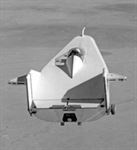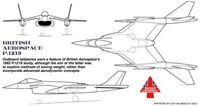Фотографии
-
Research into unusual flying shapes, particularly the tailless aircraft and delta wing, was advanced in pre-war Germany by designers including Alexander Lippisch. He designed the Delta I for the Rhoen-Rossitten Association gliding club, which flew with a Bristol Cherub engine, as seen here, in 1931. Note the fins with rudders attached to the wingtips.
Самолёты на фотографии: Lippisch Delta I - Германия - 1930
-
The flying bathtub - the NASA M2-F1 was a lifting body designed to explore the possibilities of landing a spacecraft horizontally after atmospheric reentry, and was fitted with OHSs on its fins. The aircraft completed some 77 flights during 1963-66, a C-47 towing the machine to height before release and free flight back to the runway at Rogers Dry Lake.
Самолёты на фотографии: NASA/Northrop M2-F2 - США - 1966
-
Регистрационный номер: N328KF SpaceShipOne at Mojave Spaceport after Flight 15P on June 21, 2004, the first privately funded human spaceflight, in which the spaceplane reached an altitude of 100-124km (328,412ft). The registration N328KF was deliberately chosen to reflect 328 kilofeet, i.e. 328,000ft, the Karman Line, or the officially designated edge of space.
Самолёты на фотографии: Rutan / Scaled Composites SpaceShipOne / WhiteKnight - США - 2003
-
Designed by Scaled Composites and built by Mojave Aerospace Ventures, a joint company established by Scaled and Microsoft founder Paul Allen, SpaceShipOne was completed in 2003, and featured tiltable booms incorporating OHSs.
Самолёты на фотографии: Rutan / Scaled Composites SpaceShipOne / WhiteKnight - США - 2003
-
The FanWing cross-flow concept comprises blades radiating from a central axis, creating a fan, which, when spun, induces a directional airflow that provides lift for the wing into which the fan is set. The inclusion of OHSs, as seen in this artist's impression, recovers energy from the wingtip vortices, increasing overall efficiency.
Самолёты на фотографии: FanWing FanWing - США - 2004
-
As the prospect of an operational jet engine became more of a reality, B& V continued to explore the tailless fighter with outboard tailplanes attached to the wing. The jet-powered P 212.03-01 was the final iteration of Vogt's tailless fighter, with a slender fuselage incorporating up to five 30mm cannon ahead of the cockpit and small fins on the wingtip fairings.
Самолёты на фотографии: Blohm und Voss P.209 / P.211 / P.212 - Германия - 1945
-
Регистрационный номер: N202VG, N348MS The odd couple - the second SpaceShipTwo, VSS Unity, and mothership White Knight Two VMS Eve take to the skies on the former's first captive-carry flight on September 8, 2016. The SpaceShipTwo retained the outboard tailplanes of its forerunner, although vestigial surfaces have also been mounted inboard of the fins.
Самолёты на фотографии: Rutan / Scaled Composites SpaceShipTwo / WhiteKnightTwo - США - 2008
-
The shape of things to come - Spaceship III VSS Imagine was rolled out in March 2021, and is essentially a production version of the experimental SpaceShipTwo. The original plan for Spaceship III was to explore point-to-point flights outside the atmosphere, but it appears that, for now, it will be used only for further space tourism.
Самолёты на фотографии: Rutan / Scaled Composites SpaceShipTwo / WhiteKnightTwo - США - 2008
-
Регистрационный номер: N339SS With its outboard tailplanes clearly visible, SpaceShipTwo VSS Enterprise glides to earth during its first test flight in 2010.
Самолёты на фотографии: Rutan / Scaled Composites SpaceShipTwo / WhiteKnightTwo - США - 2008
-
The Vought XF5U was a development of the company's V-173 "flying flapjack", Charles Zimmerman's experiment into a very-low-aspect-ratio wing. Both had outboard tailplanes, as evident in this photograph of the completed XF5U, fitted with Pratt & Whitney R-2000 Twin Wasp engines driving massive cuff-bladed propellers.
Самолёты на фотографии: Vought F5U - США - 1947
-
Outboard tailplanes were a feature of British Aerospace's 1982 P.1219 study, although the aim of the latter was to explore methods of saving weight, rather than incorporate advanced aerodynamic concepts.
Самолёты на фотографии: BAe P.1214 Harrier II / P.1216 / P.1219 - Великобритания - 1980
-
Skoda-Kauba Flugzeugbau was established in Prague in 1942, as a collaboration between Austrian designer Otto Kauba and the venerable Czechoslovakian industrial organisation. The SL6 was a modified version of the company's V6 twin-boom pusher, and incorporated outboard tailplanes on booms extending rearwards from the tips of the straight-tapered wing.
Самолёты на фотографии: Skoda-Kauba V.6 / SL.6 - Чехословакия - 1944
-
The Blohm & Voss P 208 was a Richard Vogt design for a tailless piston-engined Hochleistungsjager (high-performance fighter), the details of which appeared in a drawing dated August 30, 1944. The aircraft was to be powered by a single six-bank 24-cylinder supercharged Junkers Jumo 222F inline engine. This iteration (P 208.03-02) has outboard tailplanes with marked anhedral and no fins.
Самолёты на фотографии: Blohm und Voss P.208 - Германия - 1944
-
A windtunnel model of Vought's ADAM II concept, which was fitted with OHSs on short booms running aft from the tips of the wing. Vought proposed to use the Air Deflection And Modulation system for all types of aircraft, from single-seat fighters and ground-attack aircraft to large military and civil transports.
Самолёты на фотографии: Vought ADAM II - США - 1968
Статьи
- -
- A.Grandolini - The king's Breguets
- C.Richards - British-built Bristol-engined Superforts?
- G.Ellis - Rhodesia's Bush Eagles (2)
- G.Inchbald - Outside edge
- G.Peerless - Hi-de-Hi Flyers!
- J.Mesnard - Trial & terror
- K.Hayward - Airbus Industrie Britain's Return
- L.Hellstrom - The CIA's defection deception
- M.Wickstead - Bringing Africa together (2)
- N.Heap - The Flying Fashionista
- N.Stroud - Goodyear's Terra campaign
- P.Davidson - Off the Beaten Track...
- P.Jarrett - Lost & Found
- P.Stoddard - Sharpening the Scimitar













